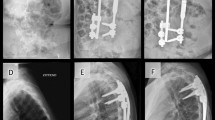Abstract
Background
The challenge when managing early-onset scoliosis (EOS) is to prevent curve progression while maintaining spinal growth. Current surgical treatments (growing rods, VEPTR) require repetitive interventions to lengthen the implants.
Questions/purposes
We asked whether a modern Luqué trolley construct could achieve and maintain scoliosis correction in EOS during spinal growth without the need for repetitive surgeries, thus decreasing the morbidity of the surgical treatment.
Methods
We retrospectively reviewed five patients who underwent a modern Luqué trolley construct between 2003 and 2008. This construct consists of inserting apical gliding spinal anchors using muscle-sparing techniques to the proximal and distal fixed anchors found in the dual growing rod construct. We documented age at surgery, correction and maintenance of deformity, spinal growth, number of procedures, and complications.
Results
The primary curve was corrected from 60° to 21° and was maintained at 21° at a minimum followup of 2 years (mean, 4 years; range, 2–5.5 years). An average of 10 vertebrae was spanned allowing the spine to grow a mean of 3 cm over 4 years, representing a mean of 77% of the expected growth. Two of the five cases outgrew the construct requiring lengthening of rods. One patient had gradual recurrence of deformity without substantial axial growth that required revision surgery after 4 years.
Conclusion
Modifications of the Luqué trolley may be useful for managing EOS without the morbidity of repetitive surgery. However, questions such as the effect of wear debris and the risk of spontaneous fusions still remain.
Level of Evidence
Level IV, therapeutic study. See Guidelines for Authors for a complete description of levels of evidence.







Similar content being viewed by others
References
Akbarnia BA. Management themes in early onset scoliosis. J Bone Joint Surg Am. 2007;89(Suppl 1):42–54.
Akbarnia BA, Breakwell LM, Marks DS, McCarthy RE, Thompson AG, Canale SK, Kostial PN, Tambe A, Asher MA. Dual growing rod technique followed for three to eleven years until final fusion: the effect of frequency of lengthening. Spine (Phila Pa 1976). 2008;33:984–990.
Akbarnia BA, Marks DS, Boachie-Adjei O, Thompson AG, Asher MA. Dual growing rod technique for the treatment of progressive early-onset scoliosis: a multicenter study. Spine (Phila Pa 1976). 2005;30(Suppl):S46–S57.
Branthwaite MA. Cardiorespiratory consequences of unfused idiopathic scoliosis. Br J Dis Chest. 1986;80:360–369.
Campbell RM Jr, Smith MD, Mayes TC, Mangos JA, Willey-Courand DB, Kose N, Pinero RF, Alder ME, Duong HL, Surber JL. The effect of opening wedge thoracostomy on thoracic insufficiency syndrome associated with fused ribs and congenital scoliosis. J Bone Joint Surg Am. 2004;86:1659–1674.
Cunningham ME, Frelinghuysen PH, Roh JS, Boachie-Adjei O, Green DW. Fusionless scoliosis surgery. Curr Opin Pediatr. 2005;17:48–53.
D’Astous JL, Sanders JO. Casting and traction treatment methods for scoliosis. Orthop Clin North Am. 2007;38:477–484, v.
Dimeglio A. Growth of the spine before age 5 years. J Pediatr Orthop Br. 1992;1:102–107.
Hasler CC, Mehrkens A, Hefti F. Efficacy and safety of VEPTR instrumentation for progressive spine deformities in young children without rib fusions. Eur Spine J. 2010;19:400–408.
James JI, Lloyd-Roberts GC, Pilcher MF. Infantile structural scoliosis. J Bone Joint Surg Br. 1959;41:719–735.
Luqué ER. Paralytic scoliosis in growing children. Clin Orthop Relat Res. 1982;163:202–209.
Luqué ER, Cardoso A. Treatment of scoliosis without arthrodesis or external support, preliminary report. Orthop Trans. 1977;1:37–38.
Mardjetko SM, Hammerberg KW, Lubicky JP, Fister JS. The Luqué trolley revisited. Review of nine cases requiring revision. Spine (Phila Pa 1976). 1992;17:582–589.
McCarthy RE, Luhmann S, Lenke L. Greater than two year follow-up Shilla growth enhancing system for the treatment of scoliosis in children. 2nd International Congress on Early Onset Scoliosis and Growing Spine (Montreal 2008). J Child Orthop. 2009;3:145–168.
McCarthy RE, Sucato D, Turner JL, Zhang H, Henson MA, McCarthy K. Shilla growing rods in a caprine animal model: a pilot study. Clin Orthop Relat Res. 2010;468:705–710.
Morrissy RT, Goldsmith GS, Hall EC, Kehl D, Cowie GH. Measurement of the Cobb angle on radiographs of patients who have scoliosis. Evaluation of intrinsic error. J Bone Joint Surg Am. 1990;72:320–327.
Pehrsson K, Larsson S, Oden A, Nachemson A. Long-term follow-up of patients with untreated scoliosis. A study of mortality, causes of death, and symptoms. Spine (Phila Pa 1976) 1992;17:1091–1096.
Pratt RK, Webb JK, Burwell RG, Cummings SL. Luqué trolley and convex epiphysiodesis in the management of infantile and juvenile idiopathic scoliosis. Spine (Phila Pa 1976) 1999;24:1538–1547.
Sanders JO, D’Astous J, Fitzgerald M, Khoury JG, Kishan S, Sturm PF. Derotational casting for progressive infantile scoliosis. J Pediatr Orthop. 2009;29:581–587.
Wild A, Jager M, Kramer R, Werner A, Krauspe R. A new technique for the surgical management of deformities in the growing spine. Biomed Tech (Berl). 2002;47:270–271.
Acknowledgment
We thank Dr Farid Alfaya for reviewing the radiographs and medical records.
Author information
Authors and Affiliations
Corresponding author
Additional information
The institution of the author receives fellowship research funding from AO Spine North America unrelated to this work. The author has had commercial associations in the form of contractual consultancies work with Synthes Europe.
About this article
Cite this article
Ouellet, J. Surgical Technique: Modern Luqué Trolley, a Self-growing Rod Technique. Clin Orthop Relat Res 469, 1356–1367 (2011). https://doi.org/10.1007/s11999-011-1783-4
Published:
Issue Date:
DOI: https://doi.org/10.1007/s11999-011-1783-4




